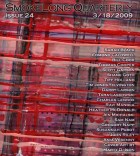This is a breathtaking story of a young family that has been broken apart. The animal vulnerability that is shared by animals and humans in this story is beautifully drawn. Were you conscious of working directly with this theme when you began writing it?
Thank you! I don’t usually approach a story with a clear theme in mind from the outset, though in retrospect I often find that my attraction to exploring a particular scene or character was thematic at root. ‘Prey’ grew out of a memory from long ago of a neighbor walking onto her bloodied porch to find her children’s pet rabbits devoured by a fox. This scene haunted me and eventually, years later and maybe not coincidentally when I had become a mother myself, the mother-character in ‘Prey’ emerged and I began to ask questions: why couldn’t she protect these animals? Why did it affect her so badly? Getting to know her better as I wrote, I began to understand how her personal vulnerability linked into the more obvious, brutal vulnerability of the attacked animals.
This is one of many lines that sticks with me: “On the back of his dented pick-up, long ago, he called her ‘my bad luck angel.'” I’m taken with this uncomfortable image! Does luck often play a large part in your fictional character’s worlds?
I do believe that luck affects our lives in more ways than we often dare admit to ourselves. In this story, though, the image of a ‘bad luck angel’ has to do with the woman’s deeply-rooted sense of guilt and helplessness. She feels, or fears, that she cannot protect her children, that everything breaks around her and she doesn’t know what to do about it. In this context, a throw-away remark by the children’s father after a near-accident takes on the meaning of a curse.
I was drawn to the very strong maternal instinct in the main character—how desperately she wishes to protect the children from more of life’s inherent violence/sadness. I’m fascinated by her inner conflict about whether to create a “fairy tale” again, or to lie to make it all better. It made her immediately likable. What is it that make us, as readers, feel for a character? Do you have any tips for accomplishing this (as you do here) in such a short space?
I believe that as readers, as human beings, we feel for others when we glimpse their humanity. By humanity I mean our frailty, our fears, our hopes—all that we don’t share openly and easily. I don’t attempt consciously to create a particular response in a reader—I believe that would make for artificial, stilted and self-conscious writing. But I do have a deep longing—as a reader, as a writer, as a human being—to understand my characters, to find out what makes them unique and what makes them vulnerable, to feel into their lives, into their humanity. When I catch a glimpse of this humanity and manage to capture it in language, it takes my breath away and moves me deeply.
What first brought you to flash fiction as both a reader and writer?
I am fascinated by flash fiction—as is so often said, this genre (and I believe it is a genre in its own right) encompasses the best of fiction and poetry. A fantastic flash may look deceptively simple, and yet it is such a challenge to make such a short piece of fiction work—when it does: wow, it is pure literary magic.
I owe my devotion to flash fiction to Claudia Smith’s writing. I stumbled upon one of her beautiful and haunting pieces in an e-zine years ago and was utterly mesmerized by what she achieves in just a few, at first seemly disjointed images. To me the best of flash fiction writing lingers in that space between reality and fantasy (or phantasy), that half-conscious space we inhabit in our dreams and day-dreams, where images are pieced together to make meaning in profound, often disturbing ways—and Claudia Smith’s work is a wonderful example of this. I followed her literary trail, discovered SLQ and writers such as Randall Brown, Kathy Fish and Steve Almond. Since, I never cease to be amazed by the rich talent amongst contemporary flash fiction writers. I’ve recently read and admired the work of Stefanie Freele, Kyle Hemmings, Davin Malasarn, Meg Pokrass and Ania Vesenny, amongst many others.
Which writers to you return to again and again for creative inspiration. Who are your literary heroes?
I am eternally and endlessly inspired by the French novelist, playwright and cinematographer Marguerite Duras. The depth and beauty of emotion carried by her simple and pure language remains—to me—unparalleled. The contemporary American writer Carole Maso is another of my ‘literary heroines’, as is the experimental writer Thalia Field. Maso and Field’s work has led me to question literary convention in ways that—I hope—enrich my own writing. Virginia Woolf, Amy Hempel, Toni Morrison, Sylvia Plath and Anne Sexton are others I come back to over and over again. I could go on … Though not altogether consciously, I find myself gravitating toward women writers, women’s voices.


 The SmokeLong Grand Micro Contest (The Mikey) is now an annual competition celebrating and compensating the best micro fiction and nonfiction online.
The SmokeLong Grand Micro Contest (The Mikey) is now an annual competition celebrating and compensating the best micro fiction and nonfiction online.